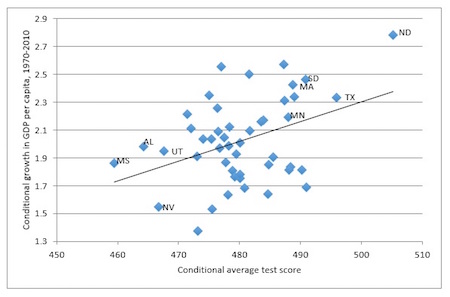Schooling policy in the U.S. is in flux. And the future of America’s state economies is at stake.
The No Child Left Behind Act that drove much of the overall policy discussion became increasingly dysfunctional and was belatedly replaced by the Every Student Succeeds Act. A key element of this new act is returning the locus of educational policy to individual states. That move is not without risk.

(AP Photo/Seth Perlman, File)
Will states move toward improving schools without the continued pressure of the federal government? Will they do better or worse when given more latitude?
History shows that vast economic gains are likely to accrue to any state that can improve the quality of its schools. But history also shows that state politics are affected both by myopia and by intense conflicts when it comes to schools. Moreover, policymakers may systematically underestimate the economic benefits of improved schools in their states.
Consider first the economic impact of school improvement. We know that states differ dramatically in income: the GDP per capita in Delaware is twice that in Mississippi. What the future will be depends on growth rates across the states, and historically these, too, have differed significantly. North Dakota’s growth over the past four decades of 3 percent per year is more than double the 1.2 percent of Nevada.
Research released last week by me, Jens Ruhose, and Ludger Woessmann shows that differences in state growth rates are directly related to the skills of the state’s workers. For the first time, we have been able to link the quality of a state’s schools to the state’s economic future. While other factors also enter, none has a long-run impact equal to improving school quality. And none can be as readily affected by public policy as the quality of a state’s schools.
We provide projections of each state’s economy based on prior patterns of state growth. For this, we first show that the growth rate of a state is highly dependent on the skills of its workforce. These skills in turn depend not only on the quality of the state’s schools but also on the quality of schools in other states and other countries that supply immigrants to each state’s workforce. Given the historical relationship between school quality and growth, it is possible to project the economic gains for each state from improving its schools by varying amounts.

What would it mean, for example, if over the next decade all states improved the performance of their students to the level of the highest achieving state, Minnesota? The aggregate present value of gains from added growth would amount to some $78 trillion, or over four times our current GDP. For New York State, an average achievement state, this would be the equivalent of an eight percent higher GDP going into the future – enough to pay fully for K-12 schools and to have considerable left over.
The gains from bringing all students up to minimal levels – something akin to NCLB but achieving its goals a decade later than originally planned – would imply a present value of aggregate gains of $32 trillion. For California, a state with a large population not reaching basic skill levels, the present value of gains from bringing up the bottom of the distribution would by historical patterns be greater than three times the current state GDP.
While states can work to attract skilled workers from other states and other countries, all states are highly dependent on their own schools to produce a skilled workforce in the future. Even with the substantial migration in the U.S., over half of the people still reside in the state in which they were born. ESSA makes it clear that each state can now have much stronger control of testing, accountability, and policy than under NCLB. Appropriate use of this authority could, by the previous projections, yield huge economic benefits.
The catch is that schooling gains take time to accrue. Schools have to improve. Only later do students move into the labor market, slowly replacing retiring (and less skilled) workers. This means that today’s politicians must have a long-run vision as they design policies under ESSA.
Perhaps more importantly, states currently face a variety of cross-pressures. The teachers unions have declared that student testing is bad, that teacher evaluation is counter-productive, and that school choice detracts from good schooling. Their answer is simply “let’s stay with what we’ve got.” This position has been reinforced by a loose confederation of “opt-outers” who advocate doing away with regular testing of students. The result is strong pressure against any change of schools and even against finding out how we are doing.
Some politicians may find it attractive to follow the immediate demands for no change from current interest groups. But forsaking both the students in their state and the long run economic interests of states will leave the state in a much poorer economic position. The research clearly indicates that no other economic development holds nearly the promise that school improvement holds.
—Eric A. Hanushek
This post originally appeared in Real Clear Education.


